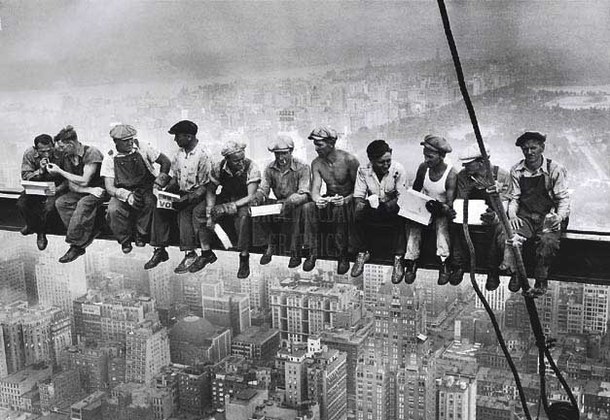Construction is a dangerous, high hazard industry that includes a wide range of activities involving construction, alterations, repairs, additions, building and renovations. These also include residential construction, bridges, roadway paving, excavations and demolitions. Yep, and blasting with explosives, working with huge machinery and dangerous electrical equipment.
Construction safety is very important to prevent fatal and non-fatal injuries as well as many other different illnesses. Workers in the construction sector have greater exposure to biological, chemical and ergonomic risk factors as well as noise and extreme temperatures. It is also one of the most physically demanding sectors.
Serious potential hazards are:
– Falling from heights / rooftops
– Unguarded machinery
– Being struck by heavy construction equipment
– Scaffold collapse
– Electric shock
– Trench collapse
– Failure to use proper protection
– Repetitive motion injuries
– Silica dust and asbestos
Nearly 6.5 million people work at approximately 252,000 construction sites across South Africa on any given day.
Things to look out for regarding your personal safety:
* aerial lifts (take the stairs, although those are hazardous for me as I keep tripping down them!)
* arc welding
* electrical and fire hazards
* bio-hazard safety (I am always spilling stuff!)
* boom collapsing (one has collapsed on my head in a parking area!)
* carbon monoxide poisoning
* carpal tunnel syndrome
* electric cord safety (don’t ever want to be shocked in that way!)
* falling objects (wear your helmet)
* eye protection (not just a fashion statement!)
* ladders (not just for the superstitious, these can really be dangerous!)
* protective clothing such as helmets, gloves, shoes, etc
* nail guns (ouch….hurts just to say it).
* power lines (not something you want to drill into, could be a shocking experience)
* power saws (turning an ordinary day into something from a scary movie)
* roof collapse
* trench safety (you don’t want to dig your own grave)
Safety Tips:
1. Use the proper tool for the designated task.
2. Frequent use of inadequate or poorly designed equipment will eventually lead to health hazards, for example tendinitis, trigger finger, white finger, carpal tunnel syndrome.
3. Protect your ears and eyes from intense noises and vibrations; opt for power tools with lower vibrations, muffled noises, and longer trigger tools.
4. Maintain good posture and balance the tools in correct alignment to your body at all times.
5. Always be aware of your surroundings. Look out for overhead lines, obstructions, low clearances, underground utilities, and other such obstacles that could prove to be a nuisance or a lethal hazard.
6. Know, understand, and follow your work space’s comprehensive safety program issued for that specific workspace, job position, and / or task at hand.
7. Don’t use damaged tools – examine each one before its use to ensure that it is in proper working condition. Maintain tools in good, clean working order
8. Never use a damaged or in any way weakened scaffold and don’t use in bad weather especially if covered with snow or ice
9. Don’t leave materials or debris abandoned or blocking exits
10. Keep tools in your belt to keep your hands free while climbing and descending.
11. Never touch a chemical spill
12. Always wear appropriate clothing and shoes respective to your job.
13. Fire extinguishers and First Aid kits must be available and readily attainable.
14. Never remove or tamper with safety devices.
15. A hard hat will protect you if there’s a risk of falling objects, as well steel-toed boots.
16. Wear gloves if you’re handling sharp objects or toxic substances.
17. Wear goggles if your work poses a hazard to your eyes.
18. Wear safety harnesses if you’re working from an elevated location and there’s the risk of falling. (If you are anything like me, you can trip and fall over literally anything. So having a guardrail or something to grab onto is really a life saver).
19. Wear a breathing mask at all times, especially if you deal with dangerous or toxic chemicals or fumes or there is poor ventilation or your workspace has debris, dust, and other flying particles.
20. Equipment onsite should have lights and reflectors. Especially when working at night, this is to see and to be seen.
All employees should be trained to understand the proper way of identifying possible hazards and understanding on how to avoid dangerous situations. They also need to be made aware of the correct procedures to follow should something happen.
The contractor is responsible for providing a safe work environment for employees and pedestrians.
Although the construction industry is dangerous, construction conditions have improved over the years. As technology increases, so do the safety and working conditions.
Knowledge is power and in this case, without knowledge that power could kill you 😉 Rather be safe than sorry and watch where you are walking 🙂
https://www.osha.gov/Publications/OSHA3252/3252.html
https://www.osha.gov/doc/
http://en.wikipedia.org/wiki/Construction_site_safety
http://ehstoday.com/construction/news/work-zone-safety-tips-5432\
http://civilengineerblog.com/construction-site-safety-tips-will-reduce-hazards-work/
About Michelle Crosby
I started my journey at Leads 2 Business in the Directory Department in 2012. I was then promoted to the Private Projects Department in 2014 and was recently promoted to Projects HOD this year.
- Web |
- More Posts(30)


